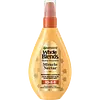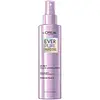What's inside
What's inside
 Key Ingredients
Key Ingredients

 Benefits
Benefits

 Concerns
Concerns

 Ingredients Side-by-side
Ingredients Side-by-side

Water
Skin ConditioningCyclopentasiloxane
EmollientPropylene Glycol
HumectantTriethanolamine
BufferingDimethiconol
EmollientPEG/PPG-17/18 Dimethicone
EmulsifyingPhenoxyethanol
PreservativeCarbomer
Emulsion StabilisingParfum
MaskingBehentrimonium Chloride
PreservativeCaprylyl Glycol
EmollientPolyquaternium-4
Potato Starch Modified
Hydroxypropyl Guar
Emulsion StabilisingAmodimethicone
Glycerin
HumectantMel
EmollientAloe Barbadensis Leaf Juice
Skin ConditioningIsopropyl Alcohol
SolventBenzyl Alcohol
PerfumingTrideceth-6
EmulsifyingCoumarin
PerfumingLimonene
PerfumingArgania Spinosa Kernel Oil
EmollientRoyal Jelly
Benzyl Salicylate
PerfumingCetrimonium Chloride
AntimicrobialPropolis Extract
Skin ConditioningCI 15985
Cosmetic ColorantAlcohol
AntimicrobialCI 19140
Cosmetic ColorantCitric Acid
BufferingPotassium Sorbate
PreservativeSodium Benzoate
MaskingWater, Cyclopentasiloxane, Propylene Glycol, Triethanolamine, Dimethiconol, PEG/PPG-17/18 Dimethicone, Phenoxyethanol, Carbomer, Parfum, Behentrimonium Chloride, Caprylyl Glycol, Polyquaternium-4, Potato Starch Modified, Hydroxypropyl Guar, Amodimethicone, Glycerin, Mel, Aloe Barbadensis Leaf Juice, Isopropyl Alcohol, Benzyl Alcohol, Trideceth-6, Coumarin, Limonene, Argania Spinosa Kernel Oil, Royal Jelly, Benzyl Salicylate, Cetrimonium Chloride, Propolis Extract, CI 15985, Alcohol, CI 19140, Citric Acid, Potassium Sorbate, Sodium Benzoate
Water
Skin ConditioningCocos Nucifera Oil
MaskingAmodimethicone
PPG-5-Ceteth-10 Phosphate
EmulsifyingPolyquaternium-37
Phenoxyethanol
PreservativeParfum
MaskingPropylene Glycol Dicaprylate/Dicaprate
EmollientSodium Hydroxide
BufferingDimethicone
EmollientBehentrimonium Chloride
PreservativePPG-1 Trideceth-6
Skin ConditioningTrideceth-6
EmulsifyingEthylhexyl Salicylate
UV AbsorberEthylhexylglycerin
Skin ConditioningPropylene Glycol
HumectantIsopropyl Alcohol
SolventSorbitan Oleate
EmulsifyingDimethiconol
EmollientLimonene
PerfumingCetrimonium Chloride
AntimicrobialLinalool
PerfumingHydroxycitronellal
PerfumingCitronellol
PerfumingCoumarin
PerfumingRosa Centifolia Extract
Skin ConditioningGeraniol
PerfumingPrunus Amygdalus Dulcis Seed Extract
Skin ConditioningTocopherol
AntioxidantXanthan Gum
EmulsifyingDehydroacetic Acid
PreservativeWater, Cocos Nucifera Oil, Amodimethicone, PPG-5-Ceteth-10 Phosphate, Polyquaternium-37, Phenoxyethanol, Parfum, Propylene Glycol Dicaprylate/Dicaprate, Sodium Hydroxide, Dimethicone, Behentrimonium Chloride, PPG-1 Trideceth-6, Trideceth-6, Ethylhexyl Salicylate, Ethylhexylglycerin, Propylene Glycol, Isopropyl Alcohol, Sorbitan Oleate, Dimethiconol, Limonene, Cetrimonium Chloride, Linalool, Hydroxycitronellal, Citronellol, Coumarin, Rosa Centifolia Extract, Geraniol, Prunus Amygdalus Dulcis Seed Extract, Tocopherol, Xanthan Gum, Dehydroacetic Acid
Ingredients Explained
These ingredients are found in both products.
Ingredients higher up in an ingredient list are typically present in a larger amount.
This water-soluble silicone is used for its hydrating and softening properties. It is used to add a silky feel to skincare products and has great benefits for haircare.
In haircare, this ingredient:
- Adds shine
- Protects color
- Offers thermal protection
- Boosts hair strength
- Does not build up as easily
This ingredient is a preservative and often used for it's anti-static properties. You'll most likely see this ingredient in hair conditioners.
It does not cause irritation or sensitization in leave-on products at 1-5%.
This ingredient is a preservative, antimicrobial, and emulsifier. It is often used in cosmetics for its ability to cleanse, condition, and reduce static.
Cetrimonium chloride is a quaternary ammonium salt, meaning it has a water-soluble structure.
Coumarins are a group of substances found naturally in plants. There are over 1300 types of coumarins identified. It has a natural vanilla scent.
Coumarin is an identified EU known allergy, meaning it may cause an allergic reaction when applied to the skin.
In many countries, coumarin is banned as a food additive. However, it can be found in soaps, tobacco products, and some alcohol drinks.
Plants use coumarins as a chemical defense. Some plants that have coumarins include lavender, tonka beans, and yellow clovers.
Learn more about CoumarinDimethiconol is a silicone that resembles the popular dimethicone. Like other silicones, it is an emollient. Emollients create a thin film on skin to prevent moisture from escaping.
This ingredient helps to create a silky texture and improve spreadability. Due to its high molecular weight and thickness, it is often combined with cyclopentasiloxane.
Isopropyl Alcohol is more commonly known as rubbing alcohol. It is most commonly used as a solvent, meaning it helps other ingredients dissolve.
This ingredient is an astringent alcohol. Astringent alcohols may also irritate skin as they high amounts may strip away your skin's natural oils.
Other types of astringent alcohols include:
According to the National Rosacea Society based in the US, you should be mindful of products with these alcohols in the top half of ingredients.
Any type of sanitizing product will have high amounts of alcohol to help kill bacteria and viruses.
Learn more about Isopropyl AlcoholLimonene is a fragrance that adds scent and taste to a formulation.
It's found in the peel oil of citrus fruits and other plants such as lavender and eucalyptus. The scent of limonene is generally described as "sweet citrus".
Limonene acts as an antioxidant, meaning it helps neutralize free radicals.
When exposed to air, oxidized limonene may sensitize the skin. Because of this, limonene is often avoided by people with sensitive skin.
The term 'fragrance' is not regulated in many countries. In many cases, it is up to the brand to define this term. For instance, many brands choose to label themselves as "fragrance-free" because they are not using synthetic fragrances. However, their products may still contain ingredients such as essential oils that are considered a fragrance.
Learn more about LimoneneParfum is a catch-all term for an ingredient or more that is used to give a scent to products.
Also called "fragrance", this ingredient can be a blend of hundreds of chemicals or plant oils. This means every product with "fragrance" or "parfum" in the ingredients list is a different mixture.
For instance, Habanolide is a proprietary trade name for a specific aroma chemical. When used as a fragrance ingredient in cosmetics, most aroma chemicals fall under the broad labeling category of “FRAGRANCE” or “PARFUM” according to EU and US regulations.
The term 'parfum' or 'fragrance' is not regulated in many countries. In many cases, it is up to the brand to define this term.
For instance, many brands choose to label themselves as "fragrance-free" because they are not using synthetic fragrances. However, their products may still contain ingredients such as essential oils that are considered a fragrance by INCI standards.
One example is Calendula flower extract. Calendula is an essential oil that still imparts a scent or 'fragrance'.
Depending on the blend, the ingredients in the mixture can cause allergies and sensitivities on the skin. Some ingredients that are known EU allergens include linalool and citronellol.
Parfum can also be used to mask or cover an unpleasant scent.
The bottom line is: not all fragrances/parfum/ingredients are created equally. If you are worried about fragrances, we recommend taking a closer look at an ingredient. And of course, we always recommend speaking with a professional.
Learn more about ParfumPhenoxyethanol is a preservative that has germicide, antimicrobial, and aromatic properties. Studies show that phenoxyethanol can prevent microbial growth. By itself, it has a scent that is similar to that of a rose.
It's often used in formulations along with Caprylyl Glycol to preserve the shelf life of products.
Propylene Glycol is an odorless, colorless liquid. As a humectant, it helps skin retain moisture. It also aids in delivering active ingredients.
Another role of this ingredient is preventing a product from melting or freezing. Propylene glycol also adds antimicrobrial properties to a product, elongating product lifespan.
This ingredient is considered an organic alcohol and commonly added into both cosmetics and foods.
Those with sensitive skin or conditions may develop a rash when using this ingredient.
Learn more about Propylene GlycolWe don't have a description for Trideceth-6 yet.
Water. It's the most common cosmetic ingredient of all. You'll usually see it at the top of ingredient lists, meaning that it makes up the largest part of the product.
So why is it so popular? Water most often acts as a solvent - this means that it helps dissolve other ingredients into the formulation.
You'll also recognize water as that liquid we all need to stay alive. If you see this, drink a glass of water. Stay hydrated!
Learn more about Water